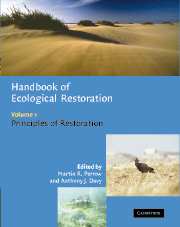Book contents
- Frontmatter
- Contents
- List of contributors
- Foreword
- Preface
- Part 1 The background
- 1 Introduction and philosophy
- 2 Rationale for restoration
- 3 The ecological context: a landscape perspective
- 4 The ecological context: a species population perspective
- 5 The evolutionary context: a species perspective
- Part 2 Manipulation of the physical environment
- Part 3 Manipulation of the chemical environment
- Part 4 Manipulation of the biota
- Part 5 Monitoring and appraisal
- Index
- References
4 - The ecological context: a species population perspective
Published online by Cambridge University Press: 29 December 2009
- Frontmatter
- Contents
- List of contributors
- Foreword
- Preface
- Part 1 The background
- 1 Introduction and philosophy
- 2 Rationale for restoration
- 3 The ecological context: a landscape perspective
- 4 The ecological context: a species population perspective
- 5 The evolutionary context: a species perspective
- Part 2 Manipulation of the physical environment
- Part 3 Manipulation of the chemical environment
- Part 4 Manipulation of the biota
- Part 5 Monitoring and appraisal
- Index
- References
Summary
INTRODUCTION
Restoration in context
Wheeler (1995) offers the generalisation, derived from consideration of plant community restoration, that a suitable end point of restoration is that restoration ‘must result in the development of a self-sustaining semi-natural habitat (under a given management regime)’. This is also applicable to restoring animal communities, a criterion for success being a viable, self-sustaining population in the wild (Griffith et al., 1989; Ebenhard, 1995; Saltz & Rubenstein, 1995; Nolet & Baveco, 1996; Sarrazin & Barbault, 1996; IUCN 1998). The requirements of restoration are very much the same for both plant and animal communities; the end product must be a self-sustaining population or community.
Restoration may be appropriate as a conservation action, either to reverse a process of deterioration and loss, or to reinstate a species which has been lost. In either case, the process of restoration may involve diverse activities. Obviously, it is restoration to repair, or even recreate, the habitat that a particular species or community require. Less obviously, restoration may involve not only the fostering of beneficial factors, but the removal of inimical ones. Thus, in the case of the water vole (Arvicola terrestris), now a threatened species in the UK, the creation of riparian habitat and the extermination of invasive American mink (Mustela vison) are equal components of restoration (Macdonald & Strachan, 1999). Similarly, there is some evidence that the restoration of rare or threatened plant species in some ecosystems can be facilitated by limiting the impact of phytophagous insects (Louda, 1994).
- Type
- Chapter
- Information
- Handbook of Ecological Restoration , pp. 47 - 65Publisher: Cambridge University PressPrint publication year: 2002
References
- 1
- Cited by

